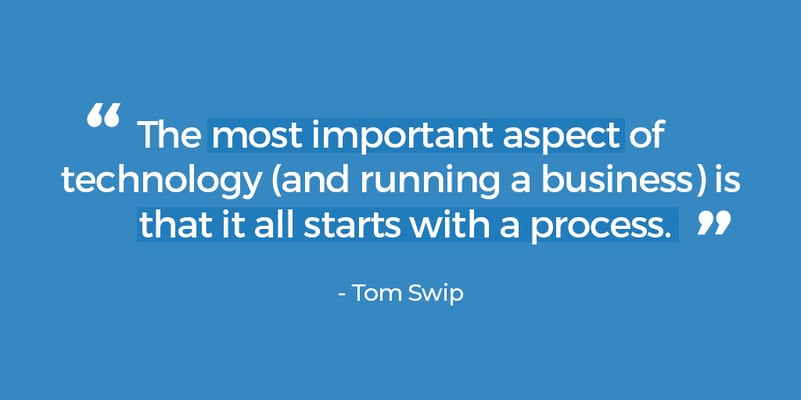
Earlier this year, the Atomic Revenue team was very excited to help lead the first-ever Midwest Manufacturing Advisers’ webinar, Tough Topics in Manufacturing, featuring speakers from Swip Systems, Mueller Prost, Evans & Dixon, and Atomic Revenue.
Since we discussed so much useful information that is still very relevant to manufacturers today, we’ve decided to share the MMA experts’ thoughts and solutions to the tough topics examined during the webinar.
From Swip Systems … How Technology Solves Issues
Tom Swip, President and CEO of Swip Systems, has been developing and streamlining business processes for over twenty-five years and possesses a wealth of knowledge about business process automation, software and application design, and network infrastructure.
Tom Question #1:
What are some of the biggest challenges you see with manufacturers not having the right technology in place?
Lack of technology can lead to:
- Limited insight – leaders don’t have access to the numbers they need to run their organization effectively.
- Excessive training – training processes aren’t streamlined or properly documented, there is too much tribal knowledge.
- Limited information access – employees have to jump through hoops or just don't have access to the information they need to do their jobs.
- Different culture – there is an outdated business mentality where information is siloed and opportunities to increase efficiency are missed.
- More risk – too much time is spent gathering information; a lot of time is spent working in the business, not necessarily on the business.
Tom Question #2:
How do other manufacturers reduce risk to their organization through technology? What are you seeing?
The most important thing about technology (and running a business in general) is that it all starts with a process. There has to be some kind of process in place, rather than everybody reinventing the wheel every day when they get into work.
Then very quickly after you implement a process, you want to adopt an operations system, such as an Entrepreneurial Operating System® or a business operating system to run your business.
Once these are in place, you can start to look at how software can help you manage the different pieces of your process. That software then creates a reproducibility, so you’re not trying to do things from scratch every time. By using software to follow a reproducible process, ultimately, it allows the company to grow faster and scale faster as a result.

Tom Question #3:
How does software help manufacturers gain insight into their organization?
The numbers don't lie. Couple that with the old adage that says, “everything that gets measured gets done.” Companies need the numbers to know exactly where they’re at in any processes and to measure how they’re doing. But if you don’t have the right numbers, then it's probably not being managed properly, and valuable insights are falling through the cracks.
If companies can get to the point where they know their most important KPIs and numbers, then that's where the software and technology can help them. They will know where they currently stand and where they need to go all at once because the information they need is at their fingertips.
Tom Question #4:
Why don't manufacturers use technology to help feed their sales funnels?
I don't know that a lot of manufacturers necessarily know what the technology sales process should look like. I'm sure they're attending trade shows, working through and maintaining leads lists, and working hard for repeat business. However, ultimately, I think it comes down to the fact that most people don't know they can actually manage the process much better with automation, by using a tool like a CRM, to gather information and use it in a better manner. Maybe they’re on the operations side or are used to building the product but aren’t very familiar with modern sales processes.
I also don't think a lot of organizations realize the impact of how a mobile app can be used to bolster their marketing activities and help facilitate conversations with clients. We’ve seen and created lots of examples of mobile apps that actually assist sales reps with their process. Maybe an app measures a certain amount of air flow through a facility to predict how much air is being lost as a result of doors being held open, or maybe it measures acoustics inside of a room with the sound capability of a mobile app.
This technology can also be used for outreach to maintain a connection with your customers, to help them solve problems, and let them know that you’re always there for them.
There are a lot of different ways that technology can help feed the sales funnel and get more people into the funnel with less cold calling and fewer email campaigns. With an app, people know that you're there and how to reach you. They’ll gladly go to a mobile app or a website to interact with you, and you don't have to go out and retrieve them.
Tom Question #5:
How do other manufacturers use software to increase communication and build culture within their organization?
What would life be like if we couldn’t immediately get the answer to any question through Google? It would be a much longer, much more manual process to retrieve much of the information we seek. If companies can quickly get employees the information they need and they don't have to go to the library or dig through reams of paper, what happens is they begin creating this culture of speed, agility, and seamless information access, and customers will sense that.
It will be readily apparent that information flows fast and your communications are operating in sync, and customers will actually be able to help you do your job more effectively.
From Mueller Prost ... Research & Development Tax Credit
Chris Hausel, R&D Tax Credit Engineer at Mueller Prost, has worked with companies of all sizes to help them take advantage of their well-earned research and experimentation tax credits. He is also a member of their Manufacturing and Distribution Committee and provides engineering assistance on tax projects using engineering skills and principles, along with knowledge gained in the tax industry.
Chris Question #1:
What is an R&D (Research and Development) tax credit?
The R&D tax credit basically incentivizes companies of all sizes, especially manufacturers, to invest in innovation, product development, product improvements, new technologies, and improved processes, software techniques, or formulas. There are also approximately 35 states that provide a state tax credit for qualified research and development.

Chris Question #2:
What determines eligibility for the R&D tax credit?
For companies to qualify for the R&D tax credit under IRC section 41, they must satisfy a four-part test:
- The first part is a qualified business component – a company (taxpayer) will qualify if they are developing a new or improved business component that is held for sale, lease, or license, or used in a trade or business of the taxpayer. These business components are defined as new or improved products, inventions, processes, techniques, formulas, or software. The qualified business component must also provide new or improved functionality, capability, performance, reliability, or quality.
- The second part is that the component must be technological in nature, so the qualified activities must rely on the principles of physical or biological sciences, engineering, or computer science to satisfy this requirement. Any activities related to market research or aesthetics are specifically non-qualified.
- The third part is there must be uncertainty at the outset. So, the research must begin with some form of technological uncertainty of the development or improvement of the business component. And this uncertainty is defined as capability (can we accomplish what is intended?), method (how do we accomplish what is intended?), or design (what specific design allows to achieve what is intended?). And the uncertainty only has to be present in one of these three areas to satisfy it.
- The fourth is that there must be a process of experimentation that's used to mitigate those uncertainties. Qualified processes of experimentation can include modeling, simulation, or systematic trial and error. Examples of the most common types of qualified activities would be rapid prototyping, developing CAD or 3D drawings.
Chris Question #3:
What are the qualified research expenditures that go into calculating the R&D tax credit?
If a company’s activity passes the four-part test, there are four eligible categories of qualified research expenditures that go into the R&D credit:
- The first bucket includes any wages or salaries paid to employees who are performing these qualified activities. You can also qualify the managers or personnel in direct supervision of those employees.
- The second bucket includes any supply costs that are incurred during the performance of qualified activities, and the supplies must be tangible and only used for performing qualified activities, meaning that capital expenditures are not eligible.
- The third bucket includes 60% of any contract research (any amount that is outsourced or subcontracted during the research, design, or testing).
- The fourth bucket includes any computer leasing or rental.
Chris Question #4:
How does a company claim the R&D Tax Credit?
Claiming the tax credit involves a study that includes both quantitative and a qualitative analysis. The IRS allows two methods for the quantitative analysis – the regular method or the alternative simplified method.
- The regular method consists of 20% of the taxpayers’ qualified research expenditures in excess of the base amount, which consists of the greater of 50% of the current year-end research expenditures or the product of the average gross receipts from the prior four years and the fixed base percentage. The fixed base percentage consists of the aggregate qualified research expenditures over the aggregate gross receipts during the base period. The base period begins when the taxpayer first begins incurring the qualified research expenditures.
- The alternative simplified method is equal to 14% of the taxpayer’s qualified research expenditures in excess of the base amount, and the base amount is equal to 50% of the average research expenditures paid or incurred over the prior three years.
For the qualitative analysis, the taxpayer must also provide qualitative information to support and prove that the qualified activities are being performed. This is necessary because if the tax credit falls under IRS examination, the supporting documentation will be used to demonstrate that research was indeed taking place. The supporting documentation can include things like the CAD and 3D design drawings, simulation results/reports, photographs, test data/reports, any research or meeting notes, or employee emails.
Chris Question #5:
What are the benefits of claiming the R&D Tax Credit?
It can provide a competitive edge to companies by not only saving them money, but by incentivizing the development or improvement of their processes or products.
There have also been some recent changes to tax laws that permit startups and taxpayers in the alternative minimum tax (AMT) position to benefit from taking advantage of this credit.
Originally companies were required to have taxable income to be eligible, but recent changes to the law also allow businesses in a loss position to take advantage of the credit and monetize their research credit by applying it against their payroll tax liability.
It’s also important to note that a business must be qualified as a small business to be eligible to offset its payroll tax liability with the research credit, and to be qualified as a small business it must be defined as a tax partnership corporation or a person with no gross receipts for any of the preceding five years.
From Evans & Dixon … Managing Employee Issues
Gerald Richardson, Labor and Employment Law Attorney and Member at Evans & Dixon, helps employers manage problems in their relationships with employees and job applicants. He has further advocated on behalf of employers in both labor and employment related litigation for thirty years.
Gerald Question #1:
Which laws protect workers who fear unsafe workplaces and what do each of those protect?
The first is the Occupational Safety and Health Act that was enacted by Congress in 1970, which essentially regulates all employers across the country. While there are about 25 States that have similar agencies and employers typically deal with them, neither Missouri nor Illinois have those state agencies.
The second major law is the National Labor Relations Act which was enacted in 1935. It essentially deals with employees’ rights to organize under labor laws in this country, and it covers both union and nonunion workshops.

Gerald Question #2:
What should manufacturers do if a worker who fears COVID-19 refuses to work?
If there is a worker who is refusing to work, the first question to ask is, “Why are you refusing to work?” If it’s due to a coronavirus-related fear, then it’s important to ask the employee to explain what his or her reasons are for the fear. It's always important when employees have issues to hear them out and invite them to express their fears.
The next step would be for the employer to discuss with the worker how they are following the guidance of the Occupational Safety and Health Administration, as well as the Center for Disease Control and Prevention.
The majority of what manufacturers must do consists of steps to ensure better hygiene, such as hand washing and social distancing, those kinds of things.
If the worker still objects, the best thing to do is send the worker home without discipline. If you do it the disciplinary way, you will likely have a response that involves some kind of legal claim.
Gerald Question #3:
How does a manufacturer lawfully discover if workers have COVID-19 symptoms?
Under the Americans with Disabilities Act, employers can usually only ask questions about an employee’s medical conditions under certain circumstances. However, there is now an exception in place for COVID-19.
The Equal Employment Opportunity Commission has issued guidance and stated that it will interpret the law to allow employers to make coronavirus-related inquiries. So, they can screen employees to determine whether workers have recently had any symptoms, measure body temperatures, and so on. Additionally, any kind of medical information that an employer receives must be kept entirely confidential and in records separate from the regular personnel records.
Gerald Question #4:
How can manufacturers protect their workers?
A lot of things are common sense in this environment: social distancing to the extent that is possible, staggering starting times, temporary break room structures, encouraging hand hygiene, and taking body temperatures. The critical temperature is 100.4°F, so if it's above that level, the worker should be sent home.
Employers can also use screening questions, asking employees if they’ve been experiencing any of the COVID-19 symptoms which include fever, cough, shortness of breath, difficulty breathing, chills, repeated shaking chills with muscle pain, headache, sore throat, or a recent loss of taste or smell.
Lastly, the routine cleaning and disinfecting of hard surfaces is another practice that protects workers, as well as avoiding the sharing of tools and equipment among workers.
Gerald Question #5:
Which manufacturers must provide paid sick leave and paid extended family leaves? Who's exempt?
As per the Families First Coronavirus Response Act, if a manufacturer has 500 or fewer employees, they must provide paid sick leave or expanded family and medical leave. There is an exception for smaller employers with 50 or fewer employees. To make a case for exemption, the manufacturer must show that, if paid leave is given, it will jeopardize the viability of their business.
From Atomic Revenue ... Sales & Marketing Challenges
Tara Kinney, CEO and Co-Founder of Atomic Revenue, draws from over fifteen years of corporate communications experience to translate complex ideas into successful marketing, sales, and customer success strategies. At Atomic Revenue, she is dedicated to developing and managing an organization of self-directed, wicked-smart problem solvers who are devoted to driving real Return on Investment (ROI) results for clients every day.

Tara Question #1:
Are there unique marketing and sales challenges for manufacturers?
The biggest challenge is that the leaders and management teams in the manufacturing industry tend to be experts in finance, production, and distribution, but they often have weaknesses or gaps in their skillsets when it comes to marketing and sales.
As a result of that gap in expertise, another challenge that presents itself is that nobody monitors the changes in market conditions or market shifts to very quickly apply changes specific to their marketing and sales departments.
Market shifts could be changes in your buyers, changes in your channel partners, and changes in pricing. Market conditions could also include changes in technology, such as the way technology supports marketing and sales, or the way buyers are using technology. Adjusting with the market would allow manufacturers to adjust sales and marketing in their market space for consistent results.
Tara Question #2:
How can manufacturers modernize their marketing and sales processes?
One thing that we notice a lot in manufacturing is reliance on the tried-and-true. Manufacturers are very process-oriented when it comes to production in their facilities and production of the things that they manufacture.
But one of the best ways to look at modernizing your marketing and sales processes is to apply some of the same kind of Six Sigma process engineering principles to how you produce revenue. And once that gets set up, it's really easy for manufacturers to be able to measure and manage their marketing and sales processes by understanding them in the same way that they do their production processes.
Another topic that manufacturers understand from their production plants is automation, which is also essential for marketing and sales. They must look at the systems and platforms that enable automation for marketing and sales processes and ask, “Do we have a good CRM in place? Do the people on our team know how to use these digital tools?”
By measuring everything that's going on in marketing and sales, manufacturers can continue to make improvements as they go forward. Without the baseline of technology and systems that help marketing and sales teams perform, they won't be able to take advantage of the ways in which they can automate processes and manage marketing and sales costs going forward.
Tara Question #3:
How do manufacturers show ROI on their marketing and sales spend?
The biggest problem is that manufacturers in all industries have all the costs in their accounting and financial departments lumped together. For example, SGA is lumped together, the labor for marketing and sales is lumped together, and the costs for agencies and technology platforms are lumped together. That ultimately means that KPIs will not be able to show a return on specific investments. Because the cost data isn’t structured in the proper way, they will never be able to measure return on investment to drive things like Cost Per Lead.
In order to really manage marketing and sales effectively, you need to get the costs and the performance data aligned so that as you make changes and continuous improvements in your marketing and sales process, you can see that the Cost per Lead, as an example, is going down.
You might increase your marketing spend, but if you increase the number of leads that you're getting to adequately support reducing your Cost Per Lead, then you are not impacting your profit margins. That relationship between finance and how finances are being managed, and aligning that with how marketing and sales are working in manufacturing, is a critical gap that is very complex to cover and fill.
To do effective ROI calculations, data hygiene within accounting platforms and cost-management systems is very important.
Tara Question #4:
What are the quick wins for low-cost, high-impact ways to increase revenue in manufacturing?
One of the lowest-cost, highest-impact departments that is not traditionally involved in revenue production but is best poised and positioned for the largest ROI is your service department.
Often, after the initial sale is made, service departments are set up to support ongoing buying and success with those purchasers. But personnel have typically not been trained and don't have the information or techniques necessary to be able to identify new sales opportunities for cross-sells and up-sells. They’re not having the types of conversations that could drive additional revenue opportunities for companies. That’s a really low-cost investment that carries a really high return.
As soon as your prospects and customers are engaged with the marketing and sales departments, they know they're being sold to. In contrast, your service department has the ability to position the offerings of your manufacturing company in a way that is of service to the customer, and the customer has let their guard down and is much more likely to buy.
One of the other low-cost, high-impact opportunities is modernizing the way manufacturing companies communicate with all their audiences, from distributors, to channel partners, to the way marketing and sales teams are communicating with prospects and audiences.
Are your service teams adopting good social media practices and really being cognizant of social listening and finding those prospecting/support opportunities within the market? Social media is absolutely the easiest way to stay in touch and monitor customers and prospects. It’s a really high-margin, low-cost way of prospecting that most companies don't engage with very effectively. And you can follow your loyal customers easily through LinkedIn and other social media, and know when they change jobs or go to new companies.
Tara Question #5:
What are the common mistakes manufacturers make when trying to increase profitability?
I think the biggest mistake manufacturers make is focusing on cogs and the goal of, “How do we reduce the production costs of the goods we're delivering?” There are so many opportunities to improve profitability by reducing the cost of sales or by improving operations with your distribution or your channel partners.
Many manufacturers will sink a ton of money into establishing distribution and channel partner agreements, yet they don't yield a lot of results because they're not effectively doing marketing and channel sales. And these avenues have to be supported in a different way than direct selling techniques.
In addition, commission structures for sales reps in manufacturing can accidentally incentivize reduced margins. Sales and marketing teams often don't have the information they need to hold customers to a certain price-point or to sell the higher-margin goods and services.
In manufacturing, commission structures set up on top-line revenue can actually increase opportunities for sales reps to reduce the price in order to close a contract. We really need to work on value messaging and emphasizing value that supports price.
Pricing structure is another thing that tends to be hit or miss in manufacturing companies: some people have really great pricing processes; other people are pricing based on how competitors are pricing. And considering that most companies don't have a really solid pricing structure, that can be dangerous to your margins.
It’s important to look at the four different facets of pricing, not only calculation and competitive positioning, but market positioning and how your customers want to buy, and the presentation of price. How is it packaged in your contracts? Is it presented so that your customers are willing to buy on a higher margin from you while not competing on price and killing your margins?
Manufacturing Tough Topics & Solutions 2.0: July 16th
If you’re struggling with hard-to-solve problems and bottlenecks in your company’s Revenue Operations process, Atomic Revenue can help! Contact us for a free RevOps assessment to discover the path that will lead you to achieve your business goals.
And be sure to join the Midwest Manufacturing Advisers as we address a second round of Tough Topics in Manufacturing at 12 pm CST on Thursday, July 16. Register for the free webinar here.
 About the Author
About the Author
Adam Patton is the Digital Operations Manager at Atomic Revenue. He believes in the power of earning trust over demanding attention, and nurturing relationships over churn-and-burn sales strategies. Pairing his background in journalism with a modern marketing skillset, Adam uses strategic storytelling to create content for social media, email campaigns, company blogs, and more. Adam’s content expertise helps create digital marketing strategies that engage customers and support Atomic Revenue’s mission and clients in obtaining customer success and revenue growth.





